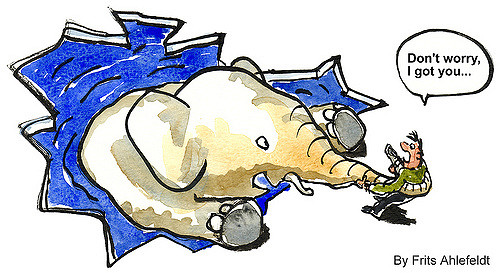|
|
|
Monday, February 4th, 2019

Poking through 12+ years of posts I find information that’s as useful now as when it was written.
Golden Oldies is a collection of the most relevant and timeless posts during that time.
I read an interesting article from Wharton on the current trend of ghosting by both candidates and employees (more on that later in the week). Today’s Oldies are kind of the yin and yang of finding and keeping people who aren’t likely to ghost.
Read other Golden Oldies here.
Talent in good times and bad (2008)
The people market is tightening (again), and the pundits are arguing (again) over whether there actually is a shortage of qualified people to fill openings across industries, especially high tech.
Is there really a shortage? Does it matter?
If there is a perceived shortage (i.e., jobs aren’t being filled), then companies will continue to fret over finding qualified people and managers will continue to worry that a lack of talent will damage their own careers.
During the most recent downturn there was an abundance of talent available as has happened in the past; for example
- The early nineties, when a typical ad for a software engineer in Silicon Valley drew 100-plus viable responses.
- Post-October 1987, when a financial services ad would easily draw five hundred qualified responses.
- The early seventies, when an ad for a microwave designer ran in the Sunday San Jose Mercury and over three hundred qualified engineers started lining up at 6 AM Monday morning to wait for the company’s doors to open.
It is neither the surplus of talent in a down market, nor the dearth of it in a tight market, that creates a staffing problem. Rather it is the attitude of many managers that if the person is not already working there must be something wrong.
In the Eighties the thought was “There must be something wrong; companies only lay off their deadwood.” In the late Nineties, it was, “There must be something wrong or this candidate would already have a job.”
Frequently the source of such attitudes is managers’ lack of confidence in the ability to make good hiring decisions. By hiring currently employed people, managers unconsciously can validate a positive hiring decision (must be good or she wouldn’t be there) or excuse a hiring mistake (assumed he was good because he was at XYZ).
Why the prevalence of this rarely-discussed-almost-never-admitted lack of hiring confidence? Why is staffing, with all its associated pieces, one of the most disliked of all management tasks?
Simply stated, most people don’t like doing things when they don’t feel competent and it is difficult to feel competent doing an intricate task for which you’ve had little-to-no training.
Staffing involves many tasks
- developing detailed reqs,
- screening resumes,
- doing substantial, time-saving phone interviews,
- creating and mentoring an interviewing team,
- interviewing,
- crafting an offer,
- closing and landing the candidate,
- avoiding post-acceptance pitfalls, and
- a myriad of other details.
Above all is the need to hire correctly; in other words, to hire the right person at the right time for the right reasons. To do it well requires sophisticated, proactive, real world-based training geared specifically to line managers.
Instead, much of the available training is geared to having an HR department or using an outside recruiter; is too mechanical; or is comprised of general psychology information.
When there is an abundance of highly qualified candidates it’s a result of the economy, not of a surplus of people.
Population demographics, baby bust to retiring Boomers, guarantee hard hiring times for a decade at least. To assure their ability to meet the staffing challenges of the twenty-first century companies and managers need to work together to
- create an efficient, proactive hiring process;
- build internal sourcing skills that work in any labor market;
- raise hiring skills to the level of core competency; and
- disseminate them throughout the organization.
The winners of the future will be the companies that can fill their needs from the available labor pool, whatever the size, and the managers whose hiring skills allow them to confidently recognize talent, no matter the source.
Boom Or Bust, People Availability Is Not The Real Problem (2006)
Talent availability goes up and down, up and down all through the town—and the country and the world.
Thanks to a strong global economy and an aging population talent has been in short supply for awhile, so if the economy slows and more talent becomes available staffing should be easier—right?
Not really. It was still difficult during the last recession when all the information channels were saying that there was an abundance of well trained, highly qualified workers available.
A looser talent pool doesn’t mean that it’s easier to hire.
And it sure doesn’t mean that turnover is less costly, because the 80/20 rule still holds true.
The overt costs (20%) during good times include recruiters, relocations, and over-sized salaries/sign-on bonuses and they all but go away during lean times.
But the covert costs (80%), including interviewers’ time, slipped schedules, lost opportunities, lost productivity, and lowered morale, are still present.
Hiring itself isn’t easy, either. In 1999, an ad might generate 80 responses, 90% of which weren’t a fit; in 2002 the same ad generated 500 responses, but 90% still didn’t fit.
Other fundamentals don’t change, either.
- A corollary of Murphy’s Law states, “No matter the condition of the labor market, the specific skills being sought by any given company at any give time will be
a. the least available skills
or
b. the same skills that are being sought by every other company,
- No matter how long or hard you work, your organization will not meet its objectives without the right talent.
- A manager’s raises, bonuses, stock options, and even job, depend on the ability to hire the right person, at the right time, for the right reasons.
- Without the ability to hire and retain people in a timely, cost-effective manner, managers are gambling with their own success. After all: You are who you hire.
- People retention is critical, and retention is the result of good hiring practices.
The days of labor famine come and go, but even in days of labor feast, staffing is too costly to ignore good retention practices.
Image credit: Willi Heidelbach
Posted in Business info, Culture, Golden Oldies, Hiring, Retention | No Comments »
Wednesday, January 30th, 2019

I especially like this post because, in today’s build-your-brand culture, it presents a solid road to success as a boss based on a radical idea: it’s not about you. You are not the be-all and end-all and even if you were it wouldn’t make you a success as a boss. It’s why, in the long run, AI won’t/can’t replace human bosses.
I joined the Marines right out of high school and started in business before I earned my degree. I had a family to support, so going the traditional student route made little sense. I earned my degree while I also worked full-time at responsible jobs. It turned out to be a good thing.
I could take classroom learning and try it on the job right away. It didn’t take long to figure out that an awful lot of the so-called expert advice was nonsense. The people in my economics textbooks, for example, didn’t act like me or any people I knew. Years later, Nobel Laureate Richard Thaler would call them “econs.”
Most of my books and most of my professors treated management as an engineering problem. There was much language about designing an effective system and “well-oiled machines.” There was plenty of advice that involved knowing what buttons to push or what levers to pull.
I learned a lot of good things, but most of the good stuff had nothing to do with working with people. I learned most of that on my own, mostly the hard way. You can have the biggest brain on Planet Earth but working with people requires your heart.
Working with people differs from working with machines. You don’t have to read a book or this blog post to figure this out. Look around you. Think about the people you work with every day.
What are People Like?
We know a lot about people. For starters, we know that we’re all imperfect. We make mistakes. That includes you. Forgive other people when they make a mistake. Admit it when you do.
People have strengths and weaknesses. You want to get the most you can out of those strengths and make those weaknesses irrelevant. People want to make progress. You should help them improve performance and spot opportunities they can seize.
People are emotional. Your computer doesn’t care if you snap at it, but your teammates do. A turret lathe won’t have a fight at home before coming to work. But pretty much everyone I know has had that experience. That’s how it is. Deal with it.
Machines can run all day, every day, for months. Buildings can last for decades with little maintenance. People are different. There’s a limit to how many hours most people can put in before productivity dwindles to almost nothing. For most of us, the top limit is somewhere between 50-55 hours a week. Overwork your people and their productivity will drop like a stone.
People need recovery time, too. After a long day, or after that big push to get a project done, people need to take time off. They need to hang out with their friends, play with their kids, go to a baseball game, or cook and consume a fine meal. Anything that’s not work-related. You interrupt that recovery time at your peril. Do it too often and people get resentful.
People thrive on good relationships. People want to work with other people they enjoy and that they can count on. Many a team has seen productivity decline because two team members couldn’t or wouldn’t get along. It’s your job to manage the work environment.
You’re A People, Too
You’re a person, too. You make mistakes. You have emotions. You have strengths and weaknesses. You want to make progress. Relationships matter a lot. You need breaks and recovery time.
One more thing. You set the example, whether or not you want to. It’s almost impossible to have a team that’s productive and happy if you’re a grumpy slacker. See to yourself first. Revel in your humanity. Draw strength from your relationships. Work hard, but get recovery time, too.
Image courtesy of Three Star Leadership
Posted in Communication, Leadership, Personal Growth, Retention | No Comments »
Monday, January 21st, 2019

Poking through 11+ years of posts I find information that’s as useful now as when it was written.
Golden Oldies is a collection of the most relevant and timeless posts during that time.
Danial Adkinson was lucky. His first boss was a true role model and taught him one of the most important lessons anyone ever learns. He was especially lucky, because he learned it at a very young age and apparently pretty smart, because it stayed with him.
Read other Golden Oldies here.
Washing dishes for Jeff was grueling, greasy work. But then again, making a pizza, or driving a truck, or baking a cake, or any of countless other jobs are not always enjoyable in themselves, either. Out of all the lessons I learned from that guy in the Pizza Hut tie, maybe the biggest is that any job can be the best job if you have the right boss. — Danial Adkison
People work for people, not companies.
People quit people, not companies.
They accept positions because of the culture and leave when it changes.
Bosses interpret company culture; they improve or pervert it; they add/subtract/polish/tarnish it.
What bosses don’t do is pass it on intact and untouched.
Flickr image credit: Susanne Nilsson
Posted in Communication, Culture, Golden Oldies, Motivation, Retention | No Comments »
Thursday, January 17th, 2019

From the Winter 2018/2019 issue of Inc. Magazine (Use the link to see the actual survey results.)
The oldest Millennials are now well into their 30s, and they’re increasingly running companies. Inc. and our sister publication, Fast Company, partnered with career-development site the Muse to survey 155 Millennial bosses to see how they manage, what they value, and how they plan to shape the future of business. The top priorities they cited are humanist: creating positive work cultures, forging strong relationships (in person, not through apps), and caring for the whole person, not just the worker. And, unlike some Boomers and Gen-Xers, they’re optimistic about those who will replace them. As Elena Valentine, co-founder and CEO of video company Skill Scout, predicts, “I have a hunch Gen Z is going to make an even bigger impact.”
Of course, the survey focused on CEOs in tech; no one seems to bother doing similar surveys on lower level millennial managers working outside of tech.
So I thought I’d share my own experience over the last 15 years with millennial managers and their workers at my small, local bank branch.
Over those years there have been roughly seven managers, all but one were promoted and are still with the bank.
Unlike large, urban branches, small branches like mine function differently. Tellers remember your name and chat; managers often handle transactions normally done by bankers.
Because I handle the banking, wires, etc., for my Russian business partner I had a lot of interactions with the managers, as well as the staff, and got to know them on a more personal level than you might expect.
The managers all ranged from their late twenties to early thirties.
They managed much the same as the CEOs in the survey. Same concerns and efforts with their peoples’ growth and well-being.
Our conversations often focused on the culture they strove to create and, for a few years, what it took to protect their people from the toxic culture and destructive behavior of a district manager (she created enough stress to put one pregnant manager on doctor-ordered bed rest) who was finally fired.
None of the managers were perfect, although the current one is as close as any manager gets, but they created great micro-cultures, in which their teams thrived.
Impressive, especially when you consider that the bank is Wells Fargo.
Image credit: Hiking Artist
Posted in Culture, Leadership, Motivation, Personal Growth, Retention | No Comments »
Monday, November 19th, 2018

Poking through 11+ years of posts I find information that’s as useful now as when it was written.
Golden Oldies is a collection of the most relevant and timeless posts during that time.
For all the promise of technology people are still people and they respond as such. Further, I doubt that’s going to change within the lifetime of anyone currently breathing.
(Note: Although the “Chat with Miki” box no longer exists, I typically reply to email within 24 hours.)
Read other Golden Oldies here.
“Clint” used the ‘Chat with Miki” box in the right-hand frame to ask me this question.
Have you ever heard this? “People usually won’t change until the pain of NOT changing exceeds the pain of changing.”
Since this is a pretty common idea I thought I’d share my ideas with everybody.
I’ve heard this and many variations of it over the years, especially when applied to the workplace where it becomes a form of management by threat
For example, if your company or boss decides on a change and people’s jobs hinge on that change, they will change.
The problem is that they will also disengage at some level, maybe a little, but sometimes a lot. Not always obviously, but over time it will show in lower productivity, less creativity and, eventually, higher turnover.
Clint then asked if I thought that vested self-interest could be used instead of increasing the pain.
The answer is absolutely.
VSI is the perfect opposite to increased pain.
By rethinking a desired action, such as change, and presenting it in terms of its value to employees you can trip the VSI switch—but not if it’s a con.
As I’ve said a million times, people are not stupid; if the desired action is not really in their best interests there is nothing you can do that will convince them. VSI will still kick in, but the result will be resume polishing, lots of LinkedIn action and conversations with recruiters.
Clint decided that by using vested self-interest he could reduce the pain of changing. He plans to connect his organization’s goals to his people’s goals, which will effectively reduce the pain and increase the likelihood that they will do what he needs them to do—painlessly.
Handy little item my chat box. Try it, I’m usually here.
Image credit: nkzs on sxc.hu
Posted in Change, Communication, Culture, Golden Oldies, Motivation, Retention | No Comments »
Monday, August 27th, 2018

Poking through 11+ years of posts I find information that’s as useful now as when it was written.
Golden Oldies is a collection of the most relevant and timeless posts during that time.
For centuries ‘customers’ were the people who bought a company’s products or services. A few decades ago that started to change and not just. Governments started recognizing that taxpayers were, in fact, customers, as did schools and universities, with regards to their students. Hospitals and doctors embraced, or were forced to, the idea of patients as customers.
Through most of that time customer service was mostly a function of caveat emptor. Even before the web and social media made both complaining and complimenting easy ‘ before that, gossip and message boards spread the word. The change is most easily seen in the medical world where Medicare/Medicaid and insurance companies, paying based on outcome, as opposed to fee-for-service, have forced radical change in patient care.
It was during this period that management academics and gurus put forth the idea that workers were customers and customer service was the responsibility of their direct boss—not HR.
Read other Golden Oldies here.
Customer service is a major topic these days (more on that tomorrow); as is employee retention, but do they really have anything in common?
Absolutely.
Every manager, from team leader to CEO, is also a customer service manager, because your people are your customers.
That’s right, customers.
More accurately, that makes you an ESM—employee service manager.
Why do you service your people? To
- help them achieve their full potential;
- assure high productivity;
- lower turnover; and
- create an environment that’s a talent magnet.
How do you service your people? By
- cultivating the kind of MAP (mindset, attitude, philosophy™) that truly values people and understands how important it is to manifest that;
- offering high-grade professional challenges to all your people and making sure that they have the resources and all the information necessary to achieve success;
- fostering fairness so that people know they are evaluated on their merits and favoritism plays no part; and
- always walking your talk and living up to your commitments.
What’s in it for you?
- Better reviews, promotions and raises;
- increased professional development;
- less turnover and easier staffing; and
- what goes around comes around—everything that you give your people will come back to you ten-fold!
Flickr image credit: Angela Archer
Posted in Culture, Golden Oldies, Motivation, Retention | 1 Comment »
Monday, August 20th, 2018

Poking through 11+ years of posts I find information that’s as useful now as when it was written.
Golden Oldies is a collection of the most relevant and timeless posts during that time.
In the six years since I wrote this individual focus on meware has skyrocketed, while focus on wetware has plunged. If this is true for you, you may want to reconsider the long-term effects, both professional and personal.
Read other Golden Oldies here.
Wally Bock writes one of the few blogs under the “leadership” banner that I like, mostly because he writes common sense, keeps it simple and (usually) sees leadership through a lens similar to my own.
In a recent post Wally writes about people.
People are emotional. Some economists write like they think it’s not so. Some philosophers think it’s bad. But it’s the way we are. Our emotions affect everything we do and every choice we make.
People are perceptive and insightful. We notice things and reach conclusions without the need for advanced programming.
People are creative. Human beings are natural idea generators. Just let us show up and watch us go.
People are both consistent and inconsistent. As a species we’re pretty predictable. Once we’re past young adulthood, our previous behavior is a good guide to our future behavior. But individually we’re a source of constant surprise.
People have knowledge. Knowledge is information plus context. On a good day, we can generate wisdom.
People have relationships. They are a source of strength and support and insight. They are also a source of biases.
People have lives. We have a life at work and a life at home and a host of other lives. They are all in play all the time.
That post reminded me of an ancient Cathy comic from the Eighties in which a computer salesman tells Cathy he knows hardware and software, but isn’t fluent in wetware.
Unfortunately, a lot of managers aren’t as fluent in wetware as they need to be to generate high levels of success for both their team and themselves.
For that matter, people in general aren’t always wetware aware, let alone fluent.
However, they seem to be both fluent and aware when it comes to meware.
The problem is that meware won’t raise productivity or drive innovation; it won’t produce responsible, well-rounded kids or create viable relationships.
When it comes to life, wetware is really all that matters, whether professionally or personally.
Flickr image credit: ThisParticularGreg
Posted in Communication, Culture, Golden Oldies, Personal Growth | No Comments »
Monday, August 6th, 2018

Poking through 11+ years of posts I find information that’s as useful now as when it was written.
Golden Oldies is a collection of the most relevant and timeless posts during that time.
A comment left on this post said the Navy’s version is “Ship, Shipmate, Self” and I’m sure the sentiment can be found embedded in the cultures of many organizations.
Unfortunately, embedding doesn’t mean complying, especially in these days of overly robust egos
Read other Golden Oldies here.
Ever noticed how some things stay with you? Many years ago, while working as a recruiter, a client VP said,
“Great managers make their decisions first for the sake of their company, second for the sake of their group and third for the sake of themselves.”
That comment comes back every time I read about another business leader whose decisions and choices were made in the opposite order, but presented as being for the good of the company.
Many of them are in jail, but many more either got off or weren’t caught in the first place; they just moved on to another role and are likely still making their decisions the same way.
Most interesting is that many managers who in reality reversed the decision order (3-2-1) see themselves as making them 1-2-3. This ties back to previously cited research showing that most of us aren’t the best evaluators of our own actions.
Basically, the question is how you evaluate your decisions before you make them. What kind of internal yardstick can you create that will assure the most 1-2-3 decisions?
Based on feedback from dozens of 1-2-3 decision-makers the common thread seems to be strong EQ and empathy, combined a high degree of objectivity and self-awareness. So how do you become self-aware and objective?
Let’s start by defining awareness. The modern definition of awareness is “having knowledge,” but the archaic definition of “vigilant” and “watchful” is more applicable.
Raising your awareness is probably most difficult because it requires you to become more objective about yourself and your actions, i.e., learning to see yourself in the third person instead of the first (seeing yourself as others see you).
Most people have some objectivity, e.g., they are able to look at a thing—clothes, jewelry, painting, furniture, house, etc.—and appreciate its beauty without wanting to own it or even actually like it.
Self-awareness is the result of cultivating that kind of third person objectivity and then focusing it on your thoughts, feelings and decisions.
A good way to build your awareness is to start with things. The next time someone asks you if you like their new whatever, stop and think about what you’re really thinking.
Most people subconsciously think about whether they like, are ambivalent or hate it. But the person asking doesn’t want to know if you want to own/wear it, they’re asking about it in terms of themself, so think about it in terms of that person, instead of in terms of yourself—in other words, think about it objectively.
Consciously listen to yourself, hear what you say from the outside, instead absorbing the content from your thoughts. Hear what others say in the context of themselves, rather than your own context.
Be sure to develop your objective side without losing the subjective one and, most importantly, be aware of which is which.
The ability to listen objectively to your own thinking is awareness and it acts as an unconscious warning system, only kicking into action when needed, not editing every comment, every move, all the time.
Image credit: Preston Rhea
Posted in Communication, Culture, Golden Oldies, Personal Growth | No Comments »
Monday, July 30th, 2018

Poking through 12+ years of posts I find information that’s as useful now as when it was written.
Golden Oldies is a collection of the most relevant and timeless posts during that time.
This post dates from 2013, but it could have been any time in the previous centuries. And not just bosses, but people in general usually look externally for the source and solution to whatever is happening. However, they are both more often found within our own MAP, our own words and our own actions.
Read other Golden Oldies here.
Everything today is about innovation, creativity, productivity and how to increase them all.
Bosses at every level read books/blogs/social media, listen to management gurus and attend seminars looking for methods and approaches that will boost all three.
They look for solutions outside, but rarely look in the mirror.
Too few bosses, no matter what happens or what feedback they receive, recognize that it’s their MAP and their actions, not their people’s, at the bottom of their under-performing groups.
After all, if you
-
- ask for input and ridicule those who offer it, why be surprised when you stop receiving it?
- tell your people you want to solve problems while they’re still molehills and then kill the messengers who bring you molehill news you shouldn’t be surprised to find yourself grappling with mountainous problems requiring substantially more resources.
- tell people their ideas are stupid, whether directly or circumspectly, or, worse, that they are for thinking of them, why should they offer themselves up for another smack with a verbal two-by-four?
I could list many more examples, but you get the idea.
Your team’s results are a direct reflection of you, so before you start ranting or whining about your group’s lack of initiative and innovation, try really listening to yourself, the feedback you receive and give, and then look in the mirror—chances are the real culprit will be looking straight back at you.
Image credit: Meeb Forman
Posted in Communication, Golden Oldies, Motivation, Personal Growth | 1 Comment »
Tuesday, June 26th, 2018

Bosses spend inordinate amounts of time, and often money, working on improving their management skills, frequently turning to the latest “thought leader” for insightful new approaches.
But trendy isn’t always good and frequently it isn’t even new.
Rather than spending your time listening to a varying roster of pundits, why not get it straight from the proverbial horse’s mouth. i.e., your workers.
Ask anyone at any level what they love most about their boss and, in one form or another, they’ll say “they listen.”
Ask what they hate and some version of “they don’t listen” usually tops the list.
Listening isn’t rocket science, but it is one of the smartest, most formidable skills you can develop that will also serve you in a myriad of situations well beyond your role as a boss.
Ironically, it’s not the actual listening that people find so daunting. Rather it’s the pre-listening step that trips so many up.
So, if your goal is to listen, then you must practice its anagram, which is to be silent.
The first is impossible without doing the second.
In other words, your ears turn off when your mouth is running.
As I said earlier, not rocket science.
Image credit: Steve Heath
Posted in Communication, Motivation, Personal Growth, Retention | No Comments »
|
 Subscribe to
Subscribe to
MAPping Company Success
About Miki 
Clarify your exec summary, website, etc.
Have a quick question or just want to chat? Feel free to write or call me at 360.335.8054
The 12 Ingredients of a Fillable Req
CheatSheet for InterviewERS
CheatSheet for InterviewEEs™
Give your mind a rest. Here are 4 quick ways to get rid of kinks, break a logjam or juice your creativity!
Creative mousing
Bubblewrap!
Animal innovation
Brain teaser
The latest disaster is here at home; donate to the East Coast recovery efforts now!
Text REDCROSS to 90999 to make a $10 donation or call 00.733.2767. $10 really really does make a difference and you'll never miss it.
And always donate what you can whenever you can
The following accept cash and in-kind donations: Doctors Without Borders, UNICEF, Red Cross, World Food Program, Save the Children
*/
?>About Miki
About KG
Clarify your exec summary, website, marketing collateral, etc.
Have a question or just want to chat @ no cost? Feel free to write
Download useful assistance now.
Entrepreneurs face difficulties that are hard for most people to imagine, let alone understand. You can find anonymous help and connections that do understand at 7 cups of tea.
Crises never end.
$10 really does make a difference and you’ll never miss it,
while $10 a month has exponential power.
Always donate what you can whenever you can.
The following accept cash and in-kind donations:
|















